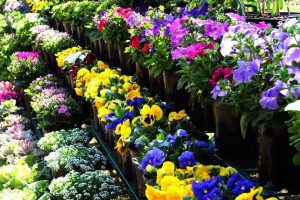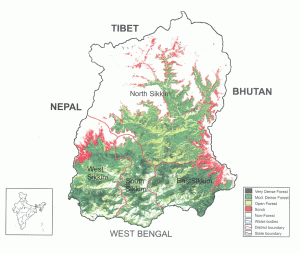Vegetation of Sikkim
- Sikkim provides a great variety of habitats, that support and sustains rich flora and fauna.
- The Vegetation of Sikkim changes from tropical to subtropical upwards through middle hills with much coniferous and Oak forests of temperate character to the higher slopes with sub alpine scrub and alpine “meadows” generally related to higher alpine flora of the north temperate zone.
- Sikkim has been known to be the most humid region in the whole range of Himalaya, because of its proximity to the Bay of Bengal and direct exposure to the south-west monsoon.
- The annual rainfall ranges from 200 – 500 cm in most of its inner valleys except for its northern most region which receives scanty rainfall.
- Throughout the year, but particularly from June to September, monsoon brings heavy rainfall to the state.
- Lower hills and valleys enjoy a sub tropical climate, warm in winter, hot and extremely humid in summer.
- Towards interior the climate becomes gradually more temperate.
Flowering Plants of Sikkim
- Sikkim is one of the biodiversity rich states of our country.
- The flowering plant diversity Sof the state with some indicative figures of dominant genera like Bulbophyllum, Calanthe, Coelogyne, Cymbidium, Dendrobium, Gentiana, Juncus, Pedicularis, Primula, Rhododendron and Swertia recorded from the region.

- Nearly 165 species have been named after the state, as they were first collected from the state or plants were known to occur in Vegetation of Sikkim.
- Some of the representative endemic species of the state have also been listed.
- One hundred ninety seven families, 1371 genera have been appended with indicative number of species of each genus known to occur in Vegetation of Sikkim.
- In all more than 4450 species of flowering plants recorded so far.
Biodiversity of Vegetation of Sikkim
- India is recognized as one of the 12 mega diversity centres of the world. Out of the 18 Biodiversity hot-spots in the world, India owns 2, namely the Western Ghats and the Eastern Himalayas.
- Sikkim covering just 0.2 % of the geographical area of the country has tremendous biodiversity and has been identified as one of the HOT-SPOT in the Eastern Himalayas.
- There are 10 bio-geographic zones & 25 biotic provinces— which have 16 major forests types & > 200 sub types as per (Champion & Seth 1968).
- Sikkim falls under Himalayan (2) Bio-geographic zone & Central Himalaya (2c) biotic province—-having about 9 types of forests types (Champion & Seth).
- The State is endowed with rich floral and faunal diversity. Species wise, the State harbors over 4500 flowering plants, 550 Orchids, 36 Rhododendrons, 16 Conifers, 28 Bamboos, 362 Ferns and its allies, 9 Tree Ferns, 30 Primulas, 11 Oaks, over 424 Medicinal plants, 144+ mammals, 550 Birds, 48 Fishes and over 600 Butterflies.
- While these figures are still not absolute, it may be kept in mind that this is only the mega-fauna and flora.
- The tremendous diversity of insects like beetles and moths as well as a host of other life forms is yet to be enumerated.
- Most of the high altitude medicinal plants are rare and endangered species.
- Sikkim also has 28 Mountains/Peaks, more than 80 Glaciers, 227 high altitude lakes/wetlands and over 104 rivers and streams.
- Nature has been particularly generous in her gift of sylvan treasures to the state of Sikkim.
- Luxuriant forest, abound in all part of state and variety of medicinal plants, herbs, shrubs, bamboos and trees growing in state is truly rich.
- In the forest, there are number of plants whose medicinal values have been well recognized by local people as well as by different pharmaceutical, insecticidal and perfumery sectors.
- Medicinal plants ought to be given the status of a “National Resources” because their sustained availability is essential to sustain one of the world’s oldest medicinal traditions, a priceless legacy of the Indian people.
- The local inhabitants for treatment of various ailments use numerous herbal remedies.
- Modern medicines owes to the flora of these mountains.
- Many inhabitants for treatment of various ailments use numerous herbal remedies.
- Many species of Himalayan origin have revolutionized the allopathic systems of medicine
Forest and Forestry of Vegetation of Sikkim
- Forest is one of the richest natural resources of Vegetation of Sikkim.
- With luxuriant forest abounding in all part of state, Forestry has been the major land use in the State and 82.31% of the total geographical area of the State is under the administrative control of the State Forest Department.

- The total forest and tree cover of the State is 3392 sq. km (47.80% of the total geographical area of the state).
- The composition ranges from tropical Dry Deciduous Forests with Sal and its associates in the valleys of Teesta and Rangit to the Alpine Scrub and grassland in high altitude.
Forest Type of Vegetation of Sikkim
| S.No. | Groups | Characteristic of Species | Altitude (Mts) | Places | ||||||
| 1. | Tropical Moist Deciduous Forest | |||||||||
| Tropical Moist Deciduous Forest | 1. Dillenia pentagyna
2. Dysoxylum floribundum 3. Gymnema arborea 4. Lagerostroemia patviflora 5. Shorea robusta 6. Toona ciliata |
250-900 | Rangpo Chhu, Sherwani, Jorethang, Rangit | |||||||
| 2. | Sub-Tropical Forest | |||||||||
| Sub-Tropical Broad Leaved Forest | 1. Albizia procera,
2. Alnus Nepalensis, 3. Bauhinia purpurea 4. Castanopsis indica, 5. Macaranga denticulate 6. Michelia champaca, 7. Schima wallichii |
1000-2000 | Tong,Gyalzing, Sangklang Selem Chakung Chhu. | |||||||
| ii)Sub Tropical Pine forests | 1. Pinus roxburghii,
2. Engelhardtia colebrookiana 3. Quercus leucotrichophora |
1000-1800 | Gangtok, Gyalzing, Rongli | |||||||
| 3. | Montantane Wet Temperate Forest | |||||||||
| i)Temperate Broad Leaved Forests |
1. Acer campbellii,
2. Engelhardtia spicata, 3. Machilus edulis, 4. Michelia cathcartii, 5. Quercus lamellose, 6. Taxus baccata |
1700-2700 | Chunthang- Lachung, Yumthang | |||||||
| ii)Mixed Coniferous temperate forest Forest |
1. Abies densa,
2. Acer campbellii, 3. Betula utiis, 4. Rhododendron, arboreum, 5. Abies densa, 6. Taxus baccata, 7. Tsuga dumosa, 8. Larix griffithianum |
2700-3000 | Lachen, Zemu, Yathang, Lachung | |||||||
| 4. | Sub-Alpine Forest | |||||||||
| Sub-Alpine Forest | 1. Abies densa,
2. Betula utiis 3. Casiope fastigata 4. Rhododendron sp. |
Above 3000 | Above Yathang | |||||||
| 5. | Moist Alpine | |||||||||
| i) Birch- Rhododendron Scrub Forest | 1. Betula utilis,
2. Sorbus foliolosa, 3. Rhododendron campanulatum, |
Above 3600 | Thangu, Maiminchu | |||||||
| ii) Deciduous Alpine Scrub |
1. Betula utilis,
2. Berberis sp., 3. Lonicera sp., 4. Rosa sp |
3600-3900 | Changu Thangu | |||||||
| iii) Dwarf Rhododen ron Scrub | 1. Rhododendron lepidotum | Above 3600 | Thangu | |||||||
| iv) Alpine pastures | 1. Allium,
2. Anemone, 3. Delphinium |
Above 4000 | Chopta Yumasong | |||||||
| b) Dry Alpine Scrub | ||||||||||
| i) Dwarf Juniperous scrub | 1. Juniperusrecurva
2. J. wallichiana |
Above 3600 | Chopta Chhangu | |||||||
| ii) Dry alpine scrub | 1. Ephedra gerardiana,
2. Meconopsis sp., 3. Ribes sp. |
Above 4000 | Chopta | |||||||
Final Destination for Sikkim PSC Notes and Tests, Exclusive coverage of SPSC Prelims and Mains Syllabus, Dedicated Staff and guidence SPSC Notes brings Prelims and Mains programs for SPSC Prelims and SPSC Mains Exam preparation. Various Programs initiated by SPSC Notes are as follows:-
- SPSC Mains Tests and Notes Program
- SPSC Prelims Exam 2024- Test Series and Notes Program
- SPSC Prelims and Mains Tests Series and Notes Program
- SPSC Detailed Complete Prelims Notes